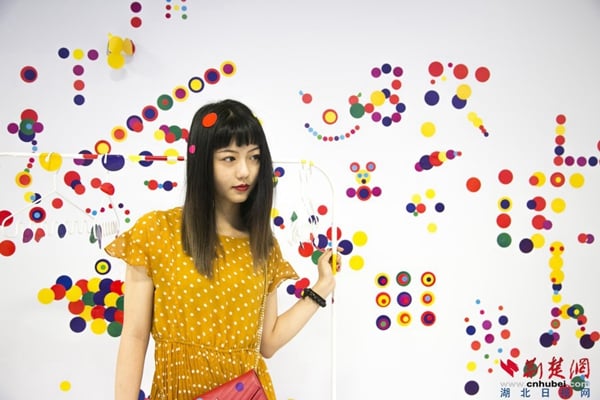
Yayoi Kusama’s attorney claims that a Chinese company has been organizing exhibitions featuring forgeries of her art, as well as the work of fellow Japanese artist Takashi Murakami. The shows allegedly began in April and have been held in the Chinese cities of Shenzhen, Guangzhou, Wuhan, and Shanghai.
According to the Nikkei Asian Review, Kusama’s lawyer, Yoshifumi Onodera, was already able to shut down a show in Shanghai that opened last month that was charging visitors approximately $10 per ticket. (The other exhibitions have been free of charge, reportedly.)
The shows were allegedly organized by a Chinese company that approached the individual venues. Onodera is looking to identify the organizers and take legal action on both the civil and criminal fronts. Murakami’s attorney, Hiroshi Kamiyama told Asian Review that he is also considering a lawsuit, saying, “this is extremely malicious.”
Art Asia Pacific reports that the Shanghai exhibition was being held at the city’s LuOne shopping mall. The facility is owned and operated by Singapore-based developers CapitaLand, which has a significant art collection of its own, featuring works by the likes of Antony Gormley, Olafur Eliasson, and Frank Stella, as well as prominent Asian artists.
A Chinese news site featured these photographs of an alleged Yayoi Kusama and Takashi Murakami exhibition in Wuhan. The works resemble Kusama’s aesthetic, but the artist’s lawyer alleges that there has been a rash of counterfeit shows of the two artists in China this year.
CapitaLand did not respond to an inquiry from artnet News as to the status of the exhibition or the authenticity of its works. A news release from ViaDirect confirms that works by Kusama and Murakami were being displayed at the mall, which opened September 22, as does a photo from the CapitaLand Facebook page.
Another show of Kusama and Murakami, which also included work by Andy Warhol, was held this year at Shanghai’s Je Fine Art Gallery. Titled “This Merry World,” it opened April 18 and was on view through May 27. The show description touted a “flowery and colorful world” featuring “three leading Pop artists.”
This photo appears to show works by Yayoi Kusama and Takashi Murakami on display at a new Shanghai shopping mall. Kusama’s lawyer claims the works are fake, and that other counterfeit exhibitions have taken place across China this year. Photo courtesy of CapitaLand via Facebook.
The gallery also included Kusama in its next exhibition, pairing her with Yoshitomo Nara in “Larger Than Life: Little Things of Yayoi Kusama & Yoshitomo Nara” (June 1–July 31, 2018). Both shows cost ¥30 ($4) to visit. It is unclear whether the gallery is involved with the unfolding controversy, and representatives had not responded to artnet News’s request for comment as of press time.
The other alleged fake exhibitions have not yet been definitively identified, but the Poly Art Space/JCA Museum in Shenzen held group show featuring Kusama, Murakami, Nara, and Damien Hirst that closed in June, according to the Shenzhen Blog. Tickets cost ¥60–108 ($8.50–15.50).
A Chinese news site featured these photographs of an alleged Yayoi Kusama and Takashi Murakami exhibition in Wuhan. The works resemble Kusama’s aesthetic, but the artist’s lawyer alleges that there has been a rash of counterfeit shows of the two artists in China this year.
The Chinese news site Vaaju wrote in May of a Murakami/Kusama show in Wuhan, with photographs depicting works such as a room covered in wallpaper that appears to feature Murakami’s signature smiley-face flower. There was also a variation on Kusama’s famed Obliteration Room, the colorful polka dots arranged not at random but in neat patterns on the white walls.
Other pieces featured red and white polka dot spheres displayed against similarly patterned walls, including a room with a mirrored cube in the middle—a strange take on Kusama’s Infinity Room concept supposedly titled Invisible Wave Point House. The article did not name a venue for the mysterious exhibition.
artnet News has reached out to Kusama’s dealer, David Zwirner Gallery, and Galerie Perrotin, which represents Murakami, as well as both artists’ lawyers, in an attempt to clear up the confusion. This article will be updated as we learn more.
UPDATE, 11/2/18:
The Yayoi Kusama Foundation has issued a statement condemning the exhibitions, with the following quote from the artist:
I am very shocked to hear that forgeries of my works have been displayed across China and many people visited these sites, believing these to be exhibitions of my works.
This is such a disappointing situation that my creations, which I’ve devoted my entire life to, have been plagiarized and exposed to everyone in an improper form. To the people of China, to everyone around the world, please stop such fraudulent exhibitions immediately. Please experience the authentic presentation of my original artworks with your own eyes.
It is my sincere wish that we can overcome these challenges and create the greatest world together.